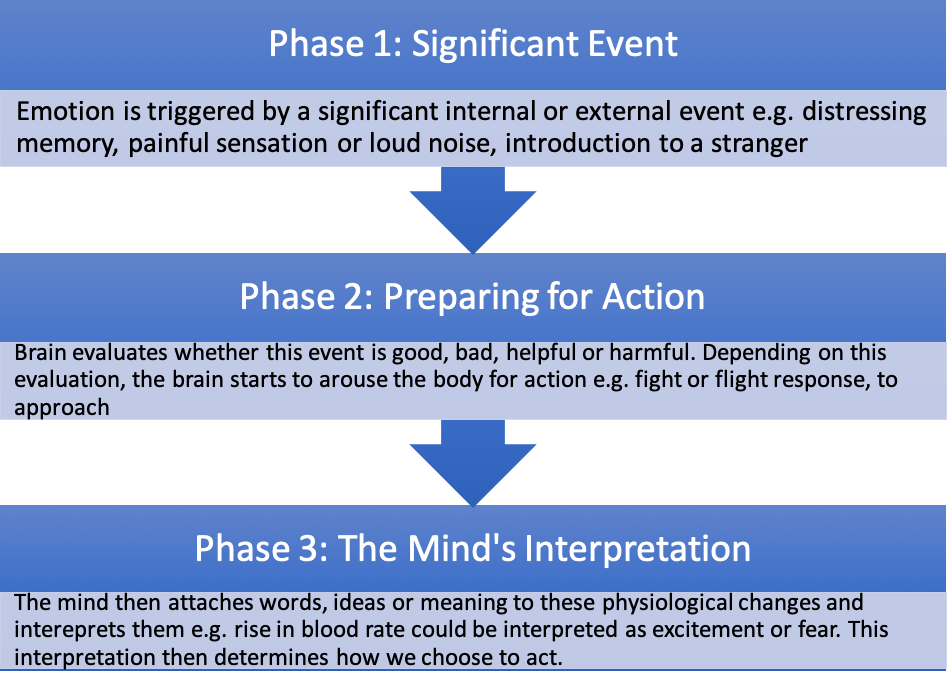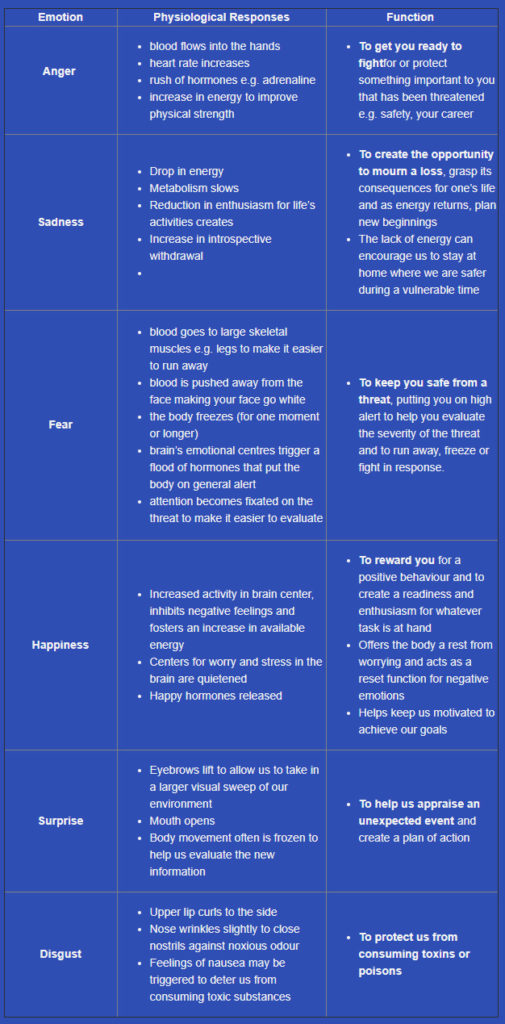
Emotions, whether fleeting or long-lasting, are an integral part of human experience. Despite this shared experience, emotions often carry negative associations. Emotions are regularly seen as overpowering and irrational inconveniences, that are weaknesses, rather than strengths.
Recent scientific research has identified how our emotions have an important evolutionary purpose, that they are designed to keep us safe through encouraging action. Far from being inconveniences, our emotions are essential tools that, when listened to, help us to survive and thrive, improving decision making, empathy levels, our social relationships and our self-awareness.
Due to misconceptions around the nature of emotions, many of us end up battling the presence of our emotions rather than harnessing them, a struggle which has been linked to long-term difficulties in mental health and wellbeing. The most common emotions that are labelled ‘negative emotions’ are anger, sadness and fear as they can often lead to us carrying out extreme behaviours that we later regret and feel were uncontrollable. However, research has found that, although we cannot control the presence of our emotions, we can control our behaviour in response to our emotions.
The finding that emotions simply send impulses to act, rather than force us to act has significant implications in how we aim to respond to our emotions. Reframing these typically negative emotions by exploring their function can give us greater control over the actions we choose to take when these emotions arise as we can stop struggling with what we can’t control, and focus on what we can.
Therefore, this month we will be exploring what emotions are, what function they serve and how you can use them as a tool, reaping the benefits of improved emotional regulation and emotional intelligence.
Definition:
Defining what emotions are is a heavily debated topic within scientific research. The word emotion stems from the Latin word “motere”, to move or to excite, identifying emotions as forces that encourage human beings to act.
A more detailed definition from Daniel Goleman, the author of Emotional Intelligencedefines emotion as “a feeling and its distinctive thoughts, psychological and biological states, and range of propensities to act”.
The exact number of emotions is heavily debated in research. To some there are hundreds, to others just six. Paul Ekman’s seminal research discovering the global universality of facial expressions related to fear, anger, sadness and happiness led way to the creation of Six Basic Emotions theory. Acting like families of emotion, each of these basic emotions have their own sub-categories of other emotions.

We have therefore seen that an emotion is a set of physiological responses triggered from a significant event that the mind interprets and encourages us to act accordingly.
Why do they do this? Most simply, to help us survive. Emotions are an incredibly ancient part of our evolutionary brain that exist to keep us safe in the world around us.
Emotions influence us to act in different ways that can vary between person to person. However, most emotions have common physiological responses and likely actions they will try to prompt within us known as ‘action tendencies’.
These physiological responses and their evolutionary functions are summarised below:

Becoming more aware of your own physiological responses to your emotions and their functions is a fantastic tool to increase control over your behaviours. Instead of being ruled by our emotions, we can learn how to identify our emotions when they arise, identify our instinctive urges to respond, and choose how we respond to our emotions that arise.
This is a key factor in increasing Emotional Intelligence (the ability to identify and manage your emotions and the emotions of others) which research has found to improve:
As a result, emotional intelligence has been linked to higher levels of business, academic, leadership and relationship success. The good news is that through responding effectively to your emotions, you can improve your emotional intelligence and use them as tools in boosting your personal success.

Follow this 5-step approach to help you identify your emotions and respond effectively. When you next experience an emotional reaction:
Observe –
Notice what physiological responses you are feeling in your body, observing precisely where those sensations are located (e.g. tingling legs, shaking hands)
Pause –
Take a moment to pause by taking a few deep breaths, focusing on physical sensations around you, or going for a walk.
Allow –
Do not try to get rid of this feeling, simply allow your emotional experience to be there.
Allow the sensation to be there even if you don’t like it or want it, by fighting the urge to get rid of this sensation we can focus on energy on how we respond.
Even if it’s not helpful in this situation, remind yourself it is there to protect you and keep you safe.
Note –either mentally or in writing, note:
What significant event triggered these physiological responses? (e.g. not feeling listened to)
What physiological sensations you are feeling?(e.g. hot flushed face, clenched fists)
What emotion you attribute to these sensations?(e.g. anger)
How is your emotion urging you to act? (e.g. to shout at this person)
Choose how to respond –
Now you have a better understanding of your internal experience and what way your emotion is urging you to act in, you can now choose how you would like to respond that helps you be the person you would like to be.
If this is still difficult, repeat steps 1-4.
Emotions are a deeply misunderstood part of human experience that, when harnessed rather than fought against, can make huge impacts ranging from helping us manage our mood, control our behaviour, increase our work success and improve our relationships.
Reframing how we see our emotions is a simple but powerful tool, why not experiment with how effective it can be?

The Workshop Lab offers insightful workshops on the topic of emotional intelligence. Employees can learn how to use their emotions ‘intelligently’ to move from chaos to calm, drive continuous improvement and maintain better relationships within the workplace.
To learn more, watch this useful TED Talk by Lisa Felman Barrett exploring the nature of our emotions and emotional intelligence.
P: 1300 364 273 | Text or Live Chat: 0401 337 711 | W: acaciaconnection.com